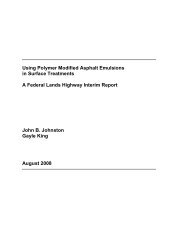Handbook for Bridge Inspections - TSP2
Handbook for Bridge Inspections - TSP2
Handbook for Bridge Inspections - TSP2
You also want an ePaper? Increase the reach of your titles
YUMPU automatically turns print PDFs into web optimized ePapers that Google loves.
A report should be made of the cover measurements incorporating<br />
the three values obtained <strong>for</strong> the load bearing rein<strong>for</strong>cements<br />
together with the average of these. An additional report should be<br />
given <strong>for</strong> the mounting rod cover.<br />
scope<br />
General<br />
Taking measurements of the cover can be relevant in the fol lowing<br />
situations:<br />
It is likely that the cover is less than Ihal described, e.g. on the<br />
underside of the bridge deck, and areas with rein<strong>for</strong>cement guides<br />
or h a lf~ lap joints.<br />
Neither rein<strong>for</strong>cement spacers nor mounting rods have been used.<br />
Clearly corroding rein<strong>for</strong>cement with little cover ava ilable.<br />
Large amount of stress due to chloride.<br />
Places where other materials investigations are being carried out.<br />
Figure 7.3-2: Measurillg the COI'cr<br />
Acceptance Inspection<br />
The cover of all concrete elements should be checked if this has<br />
not already been done during the construction phase. For small<br />
bridges such as culverts and single-span simply supported bridges<br />
at least ten measurements should be taken of the cover spread over<br />
both Ihe super and substructures. For larger bridges the scope of<br />
testing should be evaluated, but should lie between 5 and 10 measurements<br />
per 100 square metres of concrete.<br />
Major Inspection<br />
If it is suspected that there is little cover, spot checks should be<br />
conducted of the cover. Should these suspicions be confinned,<br />
then the scope of the inspections can be extended.<br />
Special <strong>Inspections</strong><br />
Measurement of the cover is 10 be carried oul in accordance with<br />
specifi c requirements. The scope and location should be adapted<br />
to the situation.<br />
Equipment<br />
Advantages and<br />
Disadvantages<br />
* Covermeter<br />
* Drawings of the rein<strong>for</strong>cement, if necessary<br />
* Folding rule<br />
* Sl ide calliper<br />
* Chalk<br />
* Hammer aclion drill <strong>for</strong> use in measurementlesting<br />
* Materials and equipment <strong>for</strong> refilling holes<br />
This is a simple, n o n~d estructive, speedy method which allows<br />
one 10 chec k large areas in a short lime. The di sadvantage is that<br />
some cover meters indicate an incorrect cover thickness <strong>for</strong> closely<br />
spaced rein<strong>for</strong>cement. Cover meters should there<strong>for</strong>e be ca libra~<br />
ted according to the density of the rein<strong>for</strong>cement.
















